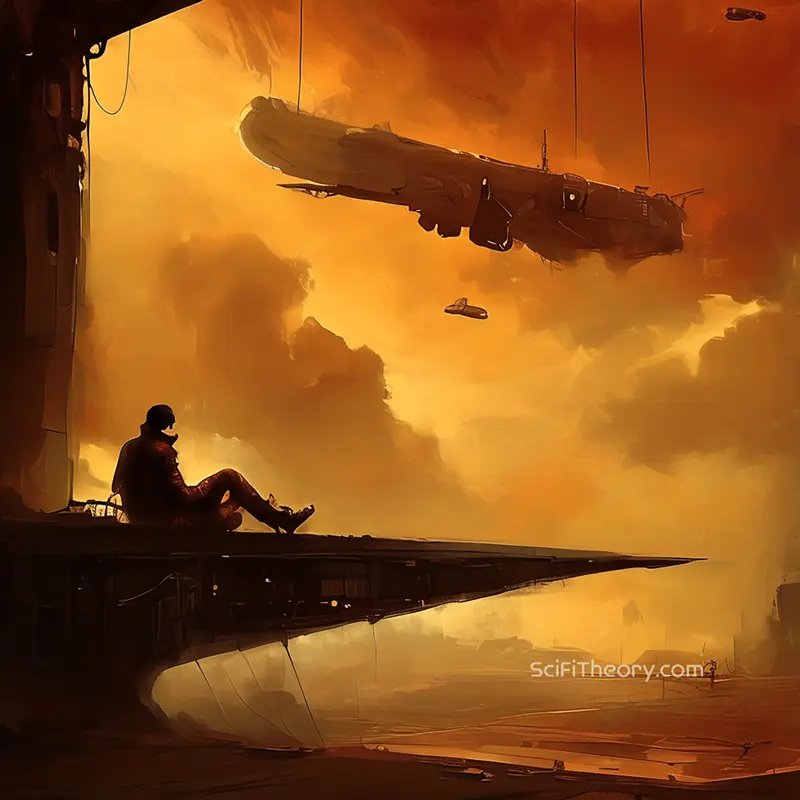In the realm of literature, where words weave intricate tapestries of human experience, the boundaries between reality and fiction have always been porous. Yet, in the genre of autofiction, these boundaries are deliberately blurred, creating a narrative space where the author’s life intertwines with the imaginative world of storytelling. It’s a genre that dances on the edge of truth and invention, inviting readers to question the very nature of identity and memory.
When this genre, with its deeply personal and introspective focus, collides with the boundless imagination of science fiction, the result is a fascinating fusion that allows authors to explore the complexities of selfhood, memory, and the human experience within the context of speculative futures and alternate realities. It’s a genre that pushes the boundaries of storytelling, inviting us to journey into worlds where the personal and the speculative intertwine in unexpected and thought-provoking ways.
The Dance of Truth and Fiction
Autofiction, a term popularized by Serge Doubrovsky in the 1970s, is a genre that defies easy categorization. It is neither pure autobiography nor pure fiction but rather a hybrid form that exists in the liminal space between the two. It is a genre that embraces the subjective nature of memory and identity, recognizing that the act of writing about one’s life is itself a form of fiction-making.
In autofiction, the author becomes both the protagonist and the narrator, blurring the lines between the real and the imagined. Real-life events are woven into the fabric of the narrative, but they are often reinterpreted, embellished, or even distorted to serve the author’s artistic vision. It’s a genre that acknowledges the inherent unreliability of memory and the impossibility of capturing the full complexity of human experience in words.
When autofiction ventures into the realm of science fiction, it opens up a world of possibilities for exploring the intersection of personal history, identity, and speculative imagination. The genre allows authors to project their own experiences, anxieties, and desires onto future worlds, alternate realities, or imagined technologies, creating narratives that are both introspective and outward-looking.
Dick’s Speculative Self-Portraits
One of the most prominent examples of autofiction within science fiction is the work of Philip K. Dick, a writer whose novels often blur the lines between his own life and the speculative worlds he creates. Dick’s exploration of themes such as reality, identity, and mental illness is deeply influenced by his own struggles with paranoia, drug use, and spiritual experiences. His novels often feature protagonists who grapple with questions of sanity and selfhood in worlds where the boundaries between the real and the unreal are constantly shifting.
In VALIS, Dick creates a narrative that is both autobiographical and speculative. The novel’s protagonist, Horselover Fat, is a thinly veiled alter ego of Dick himself, and much of the novel’s plot revolves around Fat’s (and by extension, Dick’s) experiences with a mystical vision of a pink beam of light, which he believes to be a divine revelation. VALIS is a quintessential example of autofiction in science fiction, as it merges Dick’s real-life experiences and beliefs with a complex, speculative narrative that explores themes of reality, divinity, and mental health. Through this blending of autobiography and fiction, Dick is able to engage with his own personal crises while simultaneously exploring broader philosophical questions about the nature of reality and the human mind.
Dick’s use of autofiction allows him to navigate the boundaries between personal truth and speculative imagination, creating narratives that are both deeply personal and universally relevant. By drawing on his own life experiences, Dick is able to create fictional worlds that resonate with readers on both an emotional and intellectual level, offering insights into the human condition through the lens of speculative fiction. His novels are not just escapist fantasies but rather explorations of the human psyche, where the boundaries between the self and the other, the real and the unreal, are constantly challenged and redefined.
Identity in the Digital Age
Autofiction in science fiction also provides a unique opportunity for authors to explore issues of identity, particularly in relation to technology, memory, and self-perception. In a world where our lives are increasingly mediated by digital technologies, where our online personas often overshadow our offline selves, and where the boundaries between the human and the machine are becoming increasingly blurred, the question of what it means to be human in the digital age takes on a new urgency.
In William Gibson’s Pattern Recognition, the protagonist Cayce Pollard is a “coolhunter” with a heightened sensitivity to branding and corporate logos. Her unique ability to identify and analyze trends is both a gift and a curse, shaping her identity and influencing her perception of the world. While not explicitly autobiographical, Pattern Recognition can be seen as an exploration of Gibson’s own preoccupations with technology, media, and the impact of globalization on identity. The novel’s speculative elements, such as the mysterious, viral footage that Cayce is hired to investigate, serve as a backdrop for a deeper exploration of the ways in which personal identity is constructed and deconstructed in a digital age. Cayce’s quest to uncover the origins of the footage becomes a journey of self-discovery, as she grapples with the fragmented nature of her own identity and the elusive nature of truth in a world saturated with information and misinformation.
Similarly, in Margaret Atwood’s The Handmaid’s Tale and its sequel The Testaments, Atwood draws on her own experiences and observations of societal trends to create a speculative world that explores themes of gender, power, and autonomy. While not strictly autofiction, Atwood’s work reflects a deep engagement with the social and political issues of her time, filtered through a speculative lens. The dystopian society of Gilead, where women are stripped of their rights and reduced to reproductive vessels, serves as a cautionary tale about the dangers of religious extremism and patriarchal control. But it is also a deeply personal narrative, exploring the resilience of the human spirit in the face of oppression and the enduring power of hope and resistance.
The Blurring of Realities
One of the defining characteristics of autofiction is its ability to blur the boundaries between reality and fiction, creating a narrative space where the two intersect and inform one another. In science fiction, this blurring of boundaries is particularly effective, as the genre itself often deals with alternate realities, speculative futures, and the manipulation of time and memory.
In Haruki Murakami’s 1Q84, the protagonist Aomame experiences a shift in reality that blurs the lines between her lived experience and an alternate version of Tokyo. While not strictly autobiographical, Murakami’s work often reflects his own experiences and philosophical musings, creating narratives that are both personal and speculative. The blending of real-world concerns with fantastical elements allows Murakami to explore themes of identity, reality, and the nature of existence in a way that resonates with the principles of autofiction. Aomame’s journey through this strange and unsettling world becomes a metaphor for the human search for meaning and connection in a world that is both familiar and alien.
Similarly, in Kazuo Ishiguro’s Never Let Me Go, the narrative blurs the lines between dystopian science fiction and personal memoir. The novel’s protagonist, Kathy H., recounts her experiences growing up in a seemingly idyllic boarding school, only to gradually reveal the dark reality that she and her classmates are clones, raised for the purpose of organ donation. Ishiguro’s narrative, while fictional, is deeply concerned with the emotional and psychological experiences of the characters, creating a story that feels intensely personal despite its speculative setting. The novel’s exploration of memory, identity, and the human condition is reflective of the themes central to autofiction, as it invites readers to question the boundaries between personal experience and speculative fiction. Kathy’s poignant and heartbreaking story forces us to confront the ethical implications of cloning and the dehumanizing effects of a society that treats individuals as mere commodities.
A New Frontier for Storytelling
The intersection of autofiction and science fiction represents a new frontier for storytelling, a space where the personal and the speculative converge to create narratives that are both deeply intimate and expansively imaginative. It is a genre that challenges us to rethink the boundaries between reality and fiction, to explore the complexities of identity in a world where technology is reshaping our lives, and to confront the ethical dilemmas of the future.
As we continue to navigate the uncharted waters of the 21st century, the insights offered by autofiction in science fiction will become increasingly valuable. It is a genre that speaks to the heart of the human condition, reminding us that even in the most fantastical of worlds, the questions of identity, memory, and the search for meaning remain central to our experience. It is a genre that invites us to dream big, to question the status quo, and to imagine a future where the human spirit can thrive amidst the challenges and possibilities of technological advancement.




